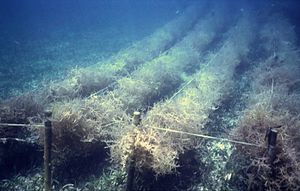
Back زراعة الأعشاب البحرية Arabic Yosun fermaları Azerbaijani Cultiu d'algues Catalan Tangopdræt Danish Vetikakasvatus Estonian Budi daya rumput laut ID Zeewierboerderij Dutch Tangoppdrett NB கடல்பாசி வளர்த்தல் Tamil Nuôi trồng rong biển Vietnamese


Seaweed farming or kelp farming is the practice of cultivating and harvesting seaweed. In its simplest form farmers gather from natural beds, while at the other extreme farmers fully control the crop's life cycle.
The seven most cultivated taxa are Eucheuma spp., Kappaphycus alvarezii, Gracilaria spp., Saccharina japonica, Undaria pinnatifida, Pyropia spp., and Sargassum fusiforme. Eucheuma and K. alvarezii are attractive for carrageenan (a gelling agent); Gracilaria is farmed for agar; the rest are eaten after limited processing.[1] Seaweeds are different from mangroves and seagrasses, as they are photosynthetic algal organisms[2] and are non-flowering.[1]
The largest seaweed-producing countries as of 2022 are China (58.62%) and Indonesia (28.6%); followed by South Korea (5.09%) and the Philippines (4.19%). Other notable producers include North Korea (1.6%), Japan (1.15%), Malaysia (0.53%), Zanzibar (Tanzania, 0.5%), and Chile (0.3%).[3][4] Seaweed farming has frequently been developed to improve economic conditions and to reduce fishing pressure.[5]
The Food and Agriculture Organization (FAO) reported that world production in 2019 was over 35 million tonnes. North America produced some 23,000 tonnes of wet seaweed. Alaska, Maine, France, and Norway each more than doubled their seaweed production since 2018. As of 2019, seaweed represented 30% of marine aquaculture.[6]
Seaweed farming is a carbon negative crop, with a high potential for climate change mitigation.[7][8] The IPCC Special Report on the Ocean and Cryosphere in a Changing Climate recommends "further research attention" as a mitigation tactic.[9] World Wildlife Fund, Oceans 2050, and The Nature Conservancy publicly support expanded seaweed cultivation.[6]
- ^ a b Reynolds, Daman; Caminiti, Jeff; Edmundson, Scott; Gao, Song; Wick, Macdonald; Huesemann, Michael (2022-07-12). "Seaweed proteins are nutritionally valuable components in the human diet". The American Journal of Clinical Nutrition. 116 (4): 855–861. doi:10.1093/ajcn/nqac190. ISSN 0002-9165. PMID 35820048.
- ^ "Seaweeds: Plants or Algae?". Point Reyes National Seashore Association. Retrieved 1 December 2018.
- ^ Zhang, Lizhu; Liao, Wei; Huang, Yajun; Wen, Yuxi; Chu, Yaoyao; Zhao, Chao (13 October 2022). "Global seaweed farming and processing in the past 20 years". Food Production, Processing and Nutrition. 4 (1). doi:10.1186/s43014-022-00103-2.
- ^ Buschmann, Alejandro H.; Camus, Carolina; Infante, Javier; Neori, Amir; Israel, Álvaro; Hernández-González, María C.; Pereda, Sandra V.; Gomez-Pinchetti, Juan Luis; Golberg, Alexander; Tadmor-Shalev, Niva; Critchley, Alan T. (2 October 2017). "Seaweed production: overview of the global state of exploitation, farming and emerging research activity". European Journal of Phycology. 52 (4): 391–406. Bibcode:2017EJPhy..52..391B. doi:10.1080/09670262.2017.1365175. ISSN 0967-0262. S2CID 53640917.
- ^ Ask, E.I (1990). Cottonii and Spinosum Cultivation Handbook. Philippines: FMC BioPolymer Corporation. p. 52.
- ^ a b Jones, Nicola (March 15, 2023). "Banking on the Seaweed Rush". Hakai Magazine. Retrieved 2023-03-19.
- ^ Wang, Taiping; Yang, Zhaoqing; Davis, Jonathan; Edmundson, Scott J. (2022-05-01). Quantifying Nitrogen Bioextraction by Seaweed Farms – A Real-time Modeling-Monitoring Case Study in Hood Canal, WA (Technical report). Office of Scientific and Technical Information. doi:10.2172/1874372.
- ^ Duarte, Carlos M.; Wu, Jiaping; Xiao, Xi; Bruhn, Annette; Krause-Jensen, Dorte (2017). "Can Seaweed Farming Play a Role in Climate Change Mitigation and Adaptation?". Frontiers in Marine Science. 4. doi:10.3389/fmars.2017.00100. hdl:10754/623247. ISSN 2296-7745.
- ^ Bindoff, N. L.; Cheung, W. W. L.; Kairo, J. G.; Arístegui, J.; et al. (2019). "Chapter 5: Changing Ocean, Marine Ecosystems, and Dependent Communities" (PDF). IPCC Special Report on the Ocean and Cryosphere in a Changing Climate. pp. 447–587.